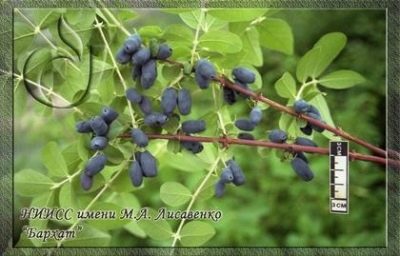
- Authors: Z.P. Zholobova, I.P. Kalinina, L.I. Gostevskikh, G.A. Prishchepina, L.A. Khokhryakova, L.A. Bondarenko (NIISS named after M.A.Lisavenko)
- Appeared when crossing: free pollination of the Altai honeysuckle variety Selena
- Year of approval: 2005
- Growth type: vigorous
- Description of the bush: medium spreading
- Bush height, m: 2
- Escapes: medium, straight, green, pubescent
- Leaves: medium, green, medium pubescent leaf blade, matte, leathery
- Transportability: good
- Flowers: medium, pale in color
Honeysuckle Velvet is an unusual variety with a Siberian character, giving stable yields every year. Despite the fact that the culture bears fruit with edible berries, the bush can also be used for decorative purposes. However, the present bitterness in the taste is not to everyone's liking. Therefore, the plant is not for everybody.
Description of the variety
The bush is vigorous, reaching a height of 2 m. The plant is compact, with a moderate spreading crown with a diameter of 1.5 m. Shoots are straight. On young stems, the bark is smooth, reddish-brown in color. Gradually, the gloss is replaced by a slight drop of gray-green color. The variety has a highly branched fibrous root system, the depth of occurrence is small.
Velvet has decorative characteristics. The stems are completely covered with bright green leaves, which change to a purple hue in autumn. The leaf blade is medium pubescent, oval, medium in size. Before the flowers bloom, the buds resemble small droplets, and then voluminous brushes of pale pink color.
Fruit characteristics
Large-fruited variety, the average weight of one berry is 0.9-1.2 g. Elongated-oval shape, with a bumpy surface and a sharp tip. The skin is dark blue, with a waxy coating that gives shine. On the middle length of the stalk, the fruits are tightly fixed, the separation is carried out with difficulty. When ripe, the berries do not crumble. The fruits retain their taste and presentation for 7-10 days if stored in a cool place.
Taste qualities
The dense and juicy pulp has a pleasant sweet-sour taste, reminiscent of citrus, with a slight bitterness, without a pronounced aroma. The variety is rated 4.5 out of 5. Despite the fact that the plant has a balanced taste, many people do not like the bitterness present in the aftertaste. But the berries are great for making confectionery fillings, jams, compotes.
Ripening and fruiting
Differs in early maturity, with mid-ripening periods. For 2 years of planting, you can already get the first harvest. Flowering occurs in May, fruits are harvested at the end of June. Ripening of berries is amicable, which can be collected at a time.
Yield
It is characterized by an annual stable harvest, which is practically unaffected by weather conditions. From one bush, you can collect from 1.9 to 2.5 kg or 51 kg / ha.

Growing regions
The peculiarities of the variety make it possible to cultivate it practically throughout the country. The frost-resistant bush is widespread in the northern and northwestern regions. The unpretentious plant attracted gardeners in temperate regions.
Self-fertility and the need for pollinators
The plant is self-fertile.Therefore, it is necessary to plant additional bushes for pollination. Any varieties with a similar flowering period are suitable for this.
Growing and care
The important thing in the successful cultivation of Velvet is to choose a suitable place. It should be as sunny as possible and protected from drafts, with deep groundwater. The variety prefers fertile soil with a neutral pH level.
They start planting bushes from the end of August to October. During this time, the culture will have time to take root and successfully overwinter. Spring planting is excluded due to the fact that honeysuckle begins sap flow early. The seedlings will root poorly, be lagging behind and may be susceptible to disease.
When planting, they adhere to a scheme of 2 m between plants and 2.5 m between rows. A hole is dug with a diameter of 50x40 cm, which is prepared in advance. The excavated garden soil is divided into 2 parts. One part is mixed with compost, wood ash and superphosphate, from which a mound is then made in a pit and a seedling is placed on it, carefully straightening the roots. The root collar is deepened 5 cm below ground level. At the end, the bush is watered abundantly and the ground is mulched.
Honeysuckle especially needs moisture during flowering and fruit ripening. If during the fruiting period the bush lacks water, the berries will become much smaller and sour. On average, one adult plant takes about 30-40 liters of water.
Irrigated abundantly closer to winter. Wet soil is slower to let the cold through. It is imperative to loosen and weed the soil from weeds. It is necessary to process the soil near the trunk with great care, since the root system is located close to the soil surface.
Unlike other varieties, Velvet does not need frequent feeding. After planting, fertilize the soil begins at the 3rd year of development. The culture needs additional spring nutrition in the form of ammonium nitrate. By winter, the plant is fed with potassium and phosphorus.


Disease and pest resistance
Velvet is practically not affected by diseases and pests. With improper agricultural technology, the leaves can be affected by powdery mildew and cercospora. A solution of copper sulfate effectively copes with the disease. In dry and hot weather, aphids attack the foliage. The bushes are sprayed with soapy water.

































































